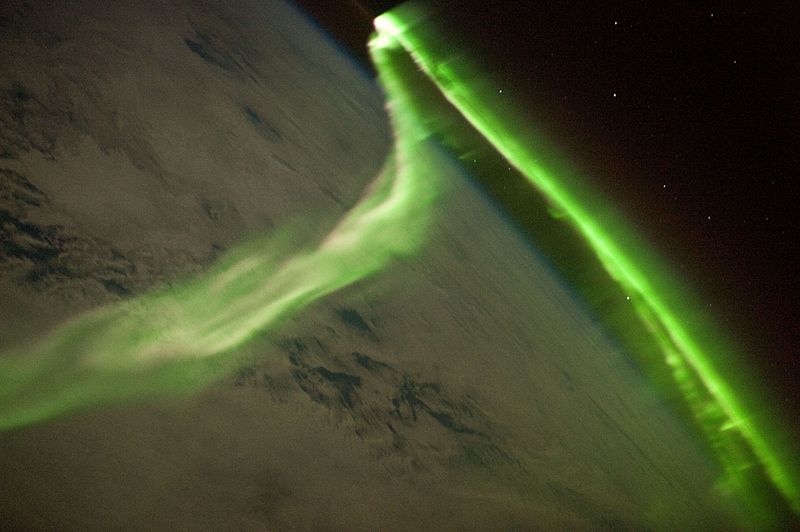Image: Aurora Australis From ISS

Description: Aurora Australis Observed From the International Space Station Among the views of Earth afforded astronauts aboard the International Space Station (ISS), surely one of the most spectacular is of the aurora. These ever-shifting displays of colored ribbons, curtains, rays, and spots are most visible near the North (aurora borealis) and South (aurora australis) Poles as charged particles (ions) streaming from the Sun (the solar wind) interact with Earth’s magnetic field. While aurora are generally only visible close to the poles, severe magnetic storms impacting the Earth’s magnetic field can shift them towards the equator. This striking aurora image was taken during a geomagnetic storm that was most likely caused by a coronal mass ejection from the Sun on May 24, 2010. The ISS was located over the Southern Indian Ocean at an altitude of 350 kilometers (220 miles), with the astronaut observer most likely looking towards Antarctica (not visible) and the South Pole. The aurora has a sinuous ribbon shape that separates into discrete spots near the lower right corner of the image. While the dominant coloration of the aurora is green, there are faint suggestions of red left of image center. Dense cloud cover is dimly visible below the aurora. The curvature of the Earth’s horizon (the limb) is clearly visible, as is the faint blue line of the upper atmosphere directly above it (at image top center). Several stars appear as bright pinpoints against the blackness of space at image top right. Auroras happen when ions in the solar wind collide with atoms of oxygen and nitrogen in the upper atmosphere. The atoms are excited by these collisions, and they typically emit light as they return to their original energy level. The light creates the aurora that we see. The most commonly observed color of aurora is green, caused by light emitted by excited oxygen atoms at wavelengths centered at 0.558 micrometers, or millionths of a meter. (Visible light is reflected from healthy (green) plant leaves at approximately the same wavelength.) Red aurora are generated by light emitted at a longer wavelength (0.630 micrometers), and other colors such as blue and purple are also sometimes observed. ISS Crew Earth Observations: ISS023-E-58455 Identification Mission ISS023 (Expedition 23) Roll E Frame 58455 Country or Geographic Name INDIAN OCEAN Features AURORA AUSTRALIS, CLOUDS, EARTH LIMB, STARS Camera Camera Tilt High Oblique Camera Nikon D3 Film 4256 x 2832 pixel CMOS sensor, 36.0mm x 23.9mm, total pixels: 12.87 million, Nikon FX format. Quality Percentage of Cloud Cover 51-75% Nadir What is Nadir? Date 2010-05-29 Time 16:11:36 Nadir Point Latitude -51.2° N Nadir Point Longitude 93.3° E Sun Azimuth 220° Spacecraft Altitude 189 nautical miles (350 km) Sun Elevation Angle -56° Orbit Number 2055
Title: Aurora Australis From ISS
Credit: Mission: ISS023 Roll: E Frame: 58455 Mission ID on the Film or image: ISS023
Author: ISS Expedition 23 crew
Usage Terms: Public domain
License: Public domain
Attribution Required?: No
Image usage
The following page links to this image:

